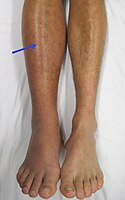
Healthcare disparities among anticoagulation therapies for severe COVID‐19 patients in the multi‐site VIRUS registry
Sign Up to like & getrecommendations! Published in 2021 at "Journal of Medical Virology"
DOI: 10.1002/jmv.26918
Abstract: Here we analyze hospitalized andintensive care unit coronavirus disease 2019 (COVID‐19) patient outcomes from the international VIRUS registry (https://clinicaltrials.gov/ct2/show/NCT04323787). We find that COVID‐19 patients administered unfractionated heparin but not enoxaparin have a higher mortality‐rate (390… read more here.
Keywords: covid patients; virus registry; patients administered; risk ratio ... See more keywords

The clinical effectiveness and safety of intravenous unfractionated heparin following digital replantation and revascularization: A narrative systematic review
Sign Up to like & getrecommendations! Published in 2022 at "Microsurgery"
DOI: 10.1002/micr.30895
Abstract: Digital replants and revascularization (DRV) have been performed since the 1960s but there are no recognized standard peri‐operative anticoagulation practices. A narrative systematic review of the clinical effectiveness and safety of therapeutic peri‐operative unfractionated heparin… read more here.
Keywords: heparin following; clinical effectiveness; systematic review; effectiveness safety ... See more keywords

Unfractionated heparin dosing requirements in the presence of inflammation during the first six months of life.
Sign Up to like & getrecommendations! Published in 2019 at "Thrombosis research"
DOI: 10.1016/j.thromres.2019.02.025
Abstract: BACKGROUND Critically ill neonates with inflammation secondary to SIRS or sepsis often develop an acquired pro-thrombotic state. Unfractionated heparin (UFH) is commonly prescribed in this population, but these subjects often remain sub-therapeutic or require very… read more here.
Keywords: sepsis; dosing requirements; age; inflammation ... See more keywords

Monitoring unfractionated heparin therapy. 4 hour-stability of anti-Xa activity in unspun citrated tubes.
Sign Up to like & getrecommendations! Published in 2019 at "Thrombosis research"
DOI: 10.1016/j.thromres.2019.10.019
Abstract: Current guidelines recommend performing laboratory tests aimed at monitoring unfractionated heparin (UFH) treatments within a delay not exceeding 1 to 2 h(s) after sampling when blood is collected into citrated tubes. As such a short delay… read more here.
Keywords: anti activity; monitoring unfractionated; delay; unfractionated heparin ... See more keywords

Comparison of Continuation of Low-Molecular-Weight Heparin versus Switching to Unfractionated Heparin in the Peripartum.
Sign Up to like & getrecommendations! Published in 2019 at "American journal of perinatology"
DOI: 10.1055/s-0039-1678667
Abstract: OBJECTIVE This study aimed to determine whether switching from low-molecular-weight heparin (LMWH) to unfractionated heparin (UFH) or its continuation in the peripartum affected anesthesia choice or bleeding complications. STUDY DESIGN A retrospective cohort study of… read more here.
Keywords: low molecular; heparin; weight heparin; molecular weight ... See more keywords

Prevention of Venous Thromboembolism in Microvascular Surgery Patients Using Weight-Based Unfractionated Heparin Infusions.
Sign Up to like & getrecommendations! Published in 2021 at "Journal of reconstructive microsurgery"
DOI: 10.1055/s-0041-1735225
Abstract: BACKGROUND Unfractionated heparin infusions are commonly used in microvascular surgery to prevent microvascular thrombosis. Previously, fixed-dose heparin infusions were believed to provide sufficient venous thromboembolism (VTE) prophylaxis; however, we now know that this practice is… read more here.
Keywords: heparin infusions; heparin; microvascular surgery; unfractionated heparin ... See more keywords

Application of anti-Xa assay in monitoring unfractionated heparin therapy in contemporary antithrombotic management
Sign Up to like & getrecommendations! Published in 2023 at "Expert Review of Hematology"
DOI: 10.1080/17474086.2023.2169126
Abstract: ABSTRACT Introduction Unfractionated heparin remains the most widely used agent in the prevention and acute treatment of thrombosis. Pharmacological complexities of this intriguing agent mandate frequent monitoring of its anticoagulant properties to maintain safe and… read more here.
Keywords: management; anti assay; assay monitoring; unfractionated heparin ... See more keywords

941: COMPARISON OF BIVALIRUDIN AND UNFRACTIONATED HEPARIN FOR ANTICOAGULATION IN VA ECMO
Sign Up to like & getrecommendations! Published in 2020 at "Critical Care Medicine"
DOI: 10.1097/01.ccm.0000633300.76272.86
Abstract: Introduction/Hypothesis: Anticoagulation for patients with indications for VA ECMO is imperative for circuit maintenance prevention of thrombotic events during extracorporeal support. There is no current standard for preferential anticoagulant or laboratory test for use with… read more here.
Keywords: anticoagulation; heparin; 941 comparison; unfractionated heparin ... See more keywords

Activated Partial Thromboplastin Time versus Anti-Factor Xa Levels for Monitoring Unfractionated Heparin Therapy in Children: An Institutional Experience
Sign Up to like & getrecommendations! Published in 2017 at "Journal of Pediatric Hematology/Oncology"
DOI: 10.1097/mph.0000000000000966
Abstract: To the Editor: Epidemiologic studies from Canada and the Netherlands estimated the incidence of venous thrombo-embolism (VTE) to be 0.07 to 0.14/10,000 children (and neonates), respectively.1,2 A recent study, however, has indicated a 70% increase… read more here.
Keywords: heparin; thromboplastin time; partial thromboplastin; unfractionated heparin ... See more keywords

The impact of unfractionated heparin or bivalirudin on patients with stable coronary artery disease undergoing percutaneous coronary intervention
Sign Up to like & getrecommendations! Published in 2018 at "Journal of Interventional Cardiology"
DOI: 10.1111/joic.12462
Abstract: OBJECTIVES To compare bleeding and clinical events of patients with stable angina or silent ischemia undergoing percutaneous coronary intervention (PCI) treated with unfractionated heparin (UFH) or bivalirudin. BACKGROUND Few direct comparisons between UFH monotherapy versus… read more here.
Keywords: bivalirudin; patients stable; percutaneous coronary; coronary intervention ... See more keywords

Thromboelastographic monitoring of the effect of unfractionated heparin in healthy dogs
Sign Up to like & getrecommendations! Published in 2017 at "Journal of Veterinary Emergency and Critical Care"
DOI: 10.1111/vec.12526
Abstract: OBJECTIVE To characterize the correlation between thromboelastography (TEG) variables using strong activators and anti-Xa (AXa) activity in healthy dogs administered subcutaneous unfractionated heparin (UFH). DESIGN Prospective experimental study. SETTING University research facility. ANIMALS Eight adult… read more here.
Keywords: teg; axa activity; unfractionated heparin; healthy dogs ... See more keywords